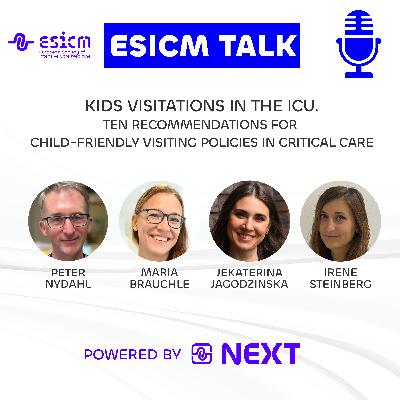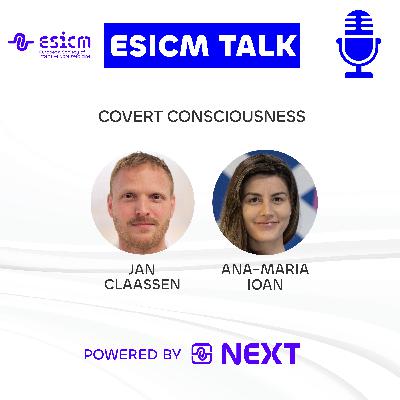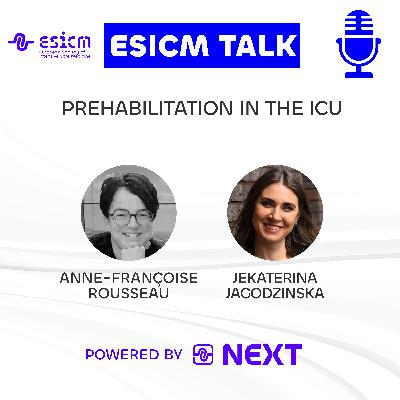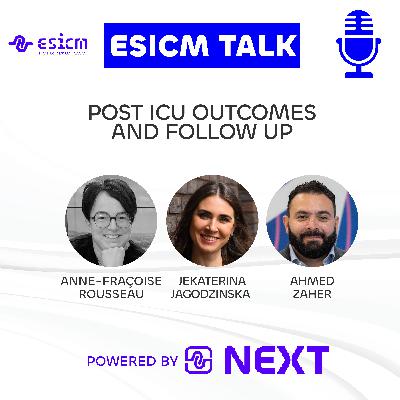Discover ESICM Talk
ESICM Talk

90 Episodes
Reverse
Did you know that preparing patients before an ICU stay can lead to better recovery after? Prehabilitation programmes focus on strengthening physical, cognitive, and metabolic health before critical illness, ensuring a smoother rehabilitation journey post-discharge.Our NEXT colleagues dive into this crucial topic with expert guests, exploring how early intervention can transform patient outcomes.Tune in now and join the conversation!
Post-Intensive Care Syndrome (PICS) refers to the prolonged impairment of physical, cognitive, and mental health that can occur after an intensive care stay. Its effects may last for over a decade after discharge. Our NEXT colleagues have explored this important topic in their podcast featuring Dr. Anne-Francoise Rousseau who addresses key questions and future strategies for managing PICS. Do not miss this opportunity —tune in now!
Admission to the intensive care unit (ICU) can be a challenging experience for patients and their families. Psychological burdens, including symptoms of anxiety, depression and post-traumatic stress, are among the most reported during the ICU stay.A recent study has been carried out as a joint project between France and the United States in which the experts have designed an intervention to improve outcomes for patients’ families. For this intervention, they evaluated the nurse facilitator to support, model and teach communication strategies that will help in securing care aligned with patients' goals at the ICU. To learn more about this intervention, we interviewed one of the main authors, Nancy Kentish Barnes. Listen to our podcast for deeper insights into this study!
The latest guidelines released from the European Society of Intensive Care Medicine (ESICM) are about end-of-life (EOL) and palliative care for critically ill adults! This comprehensive work, developed by an international, multi-disciplinary team of clinical experts, a methodologist, and patient and family representatives, is now accessible to all clinicians. We had the privilege of interviewing Prof. Kesecioglu, who led this remarkable project. Listen to this interview and explore the rationale and methodology behind the guidelines and hear the initial feedback following their release.
Mechanical ventilation (MV) can impair gas exchange, destabilise hemodynamics, and injure endothelial cells. Intravenous (IV) fluid therapy helps to restore hemodynamics and ensure adequate distal organ perfusion. However, the interplay between restrictive and liberal fluid strategies due to the complex physiological interaction between the heart and lungs may affect ventilation and risk organ damage in critically ill patients. Tune in to our next podcast and learn more about the fluids-MV interplay!
The early initiation of vasopressors, ideally within the first hour of diagnosing septic shock, is emerging as a preferred strategy. This approach offers a multimodal action with potential benefits, including reduced morbidity and mortality. Prompt vasopressor therapy is crucial for effective management in septic shock patients. To dive deeper into the timing and administration of vasopressors, join us for our next podcast! Michele Chew and Mathieu Jozwiak will guide us through the essentials—don’t miss it!
Acute exacerbations of chronic obstructive pulmonary disease (AECOPD) represent sudden and severe declines in airway function and respiratory symptoms in COPD patients. The clinical presentation of AECOPD is diverse, demanding a treatment approach tailored to disease severity—beginning with antibiotic therapy and, in critical cases, advancing to mechanical ventilation for respiratory support. Tune into our next podcast to learn more!
Septic shock triggers a dangerous drop in blood pressure and restricts blood flow to vital organs, making rapid intervention essential to prevent organ failure. This podcast will explore the power of a multimodal treatment approach—combining tailored medications, precise dosing, and supportive therapies—to amplify the body’s response to vasopressors.Don’t miss this insightful discussion!
Autonomic dysfunction and tachycardia are strongly linked to poor outcomes in septic shock, contributing to high mortality rates. In the upcoming podcast, we explore whether β-blockade with landiolol for up to 14 days can reduce organ failure, as measured by the Sequential Organ Failure Assessment (SOFA) score, in critically ill patients with tachycardia and septic shock who have been on high-dose norepinephrine for over 24 hours. Dr. Tony Whitehouse, interviewed by two NEXT representatives, discusses the key findings of the STRESS-L Randomized Clinical Trial.
Aneurysmal subarachnoid hemorrhage (aSAH) is a rare but devastating condition, marked by high global rates of fatality and long-term disability. Key factors influencing patient outcomes include early brain injury, aneurysm rebleeding, and delayed cerebral ischemia. In this podcast, Dr. Chiara Robba and Dr. Laura Galarza explore the epidemiology, treatment strategies, and the identification and management of post-aSAH complications. This exclusive discussion provides valuable insights and practical clinical guidance specifically designed for intensivists.
Esophageal pressure measurement plays a crucial role in estimating transpulmonary pressure, with both its absolute values and variations being key factors in assessing lung injury from mechanical forces during ventilation. To gain deeper insights into esophageal pressure monitoring and the essential equipment required for accurate measurement, tune in to the NEXT podcast. Luigi Zattera, the NEXT representative, conducted an insightful interview with Lise Piquilloud, head of the Acute Respiratory Failure (ARF) section.
Inspiratory muscle training (IMT) aims to enhance the strength and endurance of respiratory muscles. Numerous clinical trials have explored the effectiveness of IMT using various training protocols, devices, and respiratory assessments. However, its adoption in clinical practice remains limited. The extent to which IMT offers clinical benefits, particularly in conjunction with pulmonary rehabilitation following respiratory failure, is still uncertain.To delve deeper into the subject and gain insights into IMT, we have invited Professor Bernie Bissett. Tune in to our podcast to hear her expert perspective.
To date, no specific pharmacotherapy has proven effective against acute respiratory distress syndrome ARDS. Results on the research domain have been ineffective in human trials, a gap attributed in part to clinical and biological heterogeneity in human ARDS. Therefore, a precision medicine approach is intended to address explicitly how such underlying heterogeneity influences response to therapy among different patients with the same diagnosis. “You can find treatment for the disease but not for syndromes and ICU is a syndrome-forward approach to patient care” says Dr Pratik Sinha who is working on ARDS phenotyping. Listen to his interview and learn more about ARDS from disease understanding to future bedside perspectives.
Cardiogenic shock accounts for up to 5% of acute heart failure presentations and around 14–16% of patients reported in cardiac intensive care datasets. It complicates up to 15% of all myocardial infarctions and is the leading cause of death post-infarction. Using pharmacological agents alone may increase left ventricular afterload and myocardial oxygen demand, resulting in complications. Thus, mechanical circulatory support (MCS) devices have emerged as important therapeutic options. As evidence remains uncertain, MCS selection depends on clinician preference and local availability.An updated systematic review and meta-analysis of high-quality RCTs and propensity score-matched studies (PSMs) was performed to compare the outcomes of MCS devices with no MCS and each other and investigate which MCS is the most effective in reducing mortality.To learn more about the findings of this study listen to this podcast.
The communication between families of critically ill patients who manifest prolonged disturbances in the consciousness such as patients under sedation, in a coma, or delirium, and the caregivers became very difficult during the stay of the patient in the ICU. On the other side, the memories of the patients are distressing and confusing and make the ICU experience for this patient very unpleasant.To overcome these difficulties and to bridge the communication, written diaries by nurses and families for and to the patients are recommended during the ICU stay. You will get a more detailed description of ICU diaries from the guests in our next podcast – the first one of 2024 from the ESICM N&AHP group.
Professional burnout has been described by WHO as a syndrome conceptualised as resulting from chronic workplace stress that has not been successfully managed. Intensive care unit (ICU) professionals are at high risk of experiencing burnout due to the presence of patients with life-threatening illnesses, the observed discrepancies in job demands, responsibility overload, workload, end-of-life issues, perception of futility and other constituting potential stressors. To talk about the prevalence, outcomes, ethical implications and management strategies of ICU professional burnout we have interviewed Dr. Michalsen. Listen to the interview in the following podcast.
























